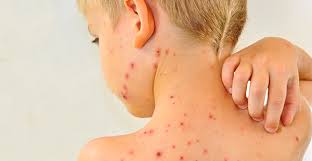Table of Contents
Measles also known as Rubeola
Measles is a highly contagious infection caused by measles virus. It is also called as rubeola. The virus causing measles infection belongs to paramyxovirus family. Once infected with measles the individual becomes immune to the virus and it cannot infect second time. Even though vaccination is available, measles infection still prevails in developing countries like Asia and Africa.
Symptoms of Measles
Symptoms usually develop 10–12 days after exposure to an infected person and last 7–10 days. Complications occur in about 30% and may include diarrhea, blindness, inflammation of brain and pneumonia among others.
- Initial signs and symptoms typically include fever, often greater than 40 °C (104.0 °F),
- Cough
- Runny nose

Measles also known as Rubeola - Red eyes
- Two or three days after the start of symptoms small white spots may form inside the mouth, known as Koplik’s spots
- A red, flat rash which usually starts on the face and then spreads to the rest of the body typically begins three to five days after the start of symptoms
Diagnosis for Measles
Measles is generally diagnosed from the combination of symptoms, especially the characteristic rash and the small spots inside the mouth. However, a simple blood or saliva test is usually done to confirm the diagnosis.
Treatment for Measles

Vaccination for measles virus is very effective and it’s the best preventive measure against the infection.
Once infection occurs there is no specific treatment. Supportive care and careful monitoring of the individual’s signs is essential. This may include giving oral rehydration solution (slightly sweet and salty fluids), healthy food, and medications to help with the fever.Antibiotics may be used if a bacterial infection such as pneumonia occurs. Vitamin A supplementation is also recommended.
The above are the Symptoms, Diagnosis and Treatment for Measles. Measles also known as Rubeola

